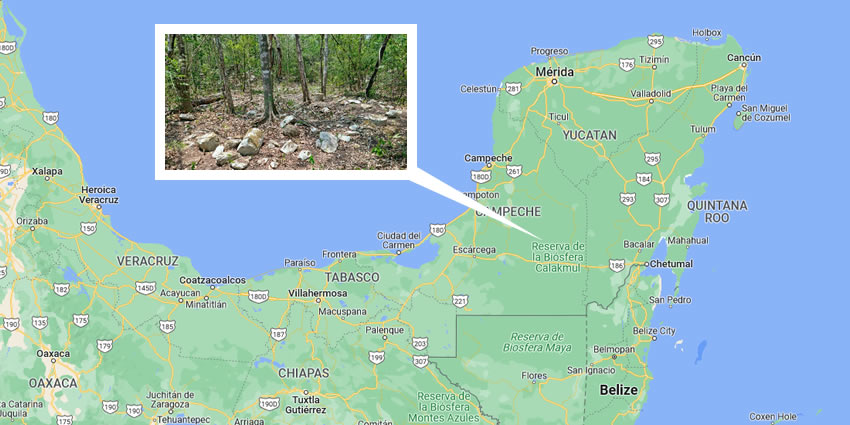
Ocomtún, an unknown ancient Mayan city, was found deep in the Mexican jungle
A team of archaeologists has discovered an ancient Mayan city with large pyramidal buildings up to 15 meters high 60 kilometers into the jungle of the Balamkú ecological reserve, in Campeche, southern Mexico.
Archaeologists have named it Ocomtún (“stone column” in Yucatec Mayan), after the numerous cylindrical stone columns that have been found scattered throughout the ancient settlement.
The monumental core of Ocomtún, which is believed to have been an important center in the Maya Central Lowlands region during the Classic period (250-1000 AD), covers more than 50 hectares and has large buildings, several with pyramidal structures.
Some of these pyramidal structures are more than 15 meters high, according to one of the archaeologists from the National Institute of Anthropology and History (INAH).
Archaeologists suspect that the numerous cylindrical columns must have been part of the entrances to the upper rooms of the buildings.
The southeast of the urban center was made up of three plazas dominated by imposing buildings.
All this central area is surrounded by various courtyard groups. Between the two main squares, there is a complex made up of various low and elongated structures, arranged almost in concentric circles; a ball game is also included.
A causeway connects this area with the northwestern part.
The most voluminous construction of the site is a rectangular acropolis, whose sides measure 80 meters and its height is about 10 m, in its northern part, there is a pyramid that stands 25 m above the natural terrain.
The unexplored area of Ocomtún
The city was located during the first field season of the project ‘Expanding the archaeological panorama of the Mayan Central Lowlands’, approved by the Archeology Council of the INAH, of the Ministry of Culture of the Government of Mexico.
This project was coordinated by an expert from the Research Center of the Slovenian Academy of Sciences and Arts. The initiative seeks to explore an extensive area of 3,000 uninhabited sq km, covered by the jungle and practically unknown to archaeology.
This area is located in the central part of the state of Campeche, bordering to the south with the Escárcega-Chetumal highway, to the east with the northern sector of the Calakmul Biosphere Reserve, and to the north with the Chenes region.
During May and mid-June 2023, the team focused on the extreme north of that area. In March 2023, that surface was scanned with LiDAR (detection sensors that use airborne lasers), and aerial images of the terrain revealed the presence of archaeological remains.
Numerous concentrations of pre-Hispanic structures were recognized that was later confirmed in field inspections, with peculiarities that contrast with what is known from other parts of the Mayan area.
The sites of the Chenes region are located near Ocomtún, more than 30 kilometers to the northeast, Nadzcaan, 36 kilometers to the southeast, and Chactún, 50 km to the southeast, reported a decade ago by this same project.
The biggest surprise turned out to be the site located on a ‘peninsula’ of high ground, surrounded by extensive wetlands”, he highlights, in whose monumental core they found large buildings with pyramidal structures more than 15 m high.
The archaeologist indicates that the most common types of ceramics that they collected on the surface and in some test pits are from the Late Classic period (600-800 AD). The analysis will give reliable data on the occupation sequences.
Ocomtún underwent alterations years later, in the Terminal Classic period (800-1000 AD).
As can be deduced from constructions with elements extracted from nearby buildings, a reflection of ideological and population changes in times of crisis that, finally, by the 10th century, led to the collapse of the complex sociopolitical organization and drastic demographic decline in the Maya Central Lowlands.
Were also explored structures in the area that extends to the La Rigueña River, with similar characteristics to Ocomtún – with stairways, monolithic columns, and the absence of monuments with inscriptions.
The researchers found several sets of unknown use, similar to the one located in the southeast complex of Ocomtún, which in some cases include the ball game, and in others, central altars.
It is possible that they are markets or spaces for community rituals, but only future research will shed light on the functions of these groups, which represent a regional peculiarity – was pointed out in the INAH note.
Let us know if this article was useful for you